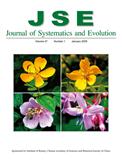Steven R. MANCHESTER, Zhi-Duan CHEN, An-Ming LU, Kazuhiko UEMURA
We review the fossil history of seed plant genera that are now endemic to eastern Asia. Although the majority of eastern Asian endemic genera have no known fossil record at all, 54 genera, or about 9%, are reliably known from the fossil record. Most of these are woody (with two exceptions), and most are today either broadly East Asian, or more specifically confined to Sino-Japanese subcategory rather than being endemic to the Sino-Himalayan area. Of the "eastern Asian endemic" genera so far known from the fossil record, the majority formerly occurred in Europe and/or North America, indicating that eastern Asia served as a late Tertiary or Quaternary refugium for taxa. Hence, many of these genera may have originated in other parts of the Northern Hemisphere and expanded their ranges across continents and former sea barriers when tectonic and climatic conditions allowed, leading to their arrival in eastern Asia. Although clear evidence for paleoendemism is provided by the gymnosperms Amentotaxus, Cathaya, Cephalotaxus, Cunninghamia, Cryptomeria, Glyptostrobus, Ginkgo, Keteleeria, Metasequoia, Nothotsuga, Pseudolarix, Sciadopitys, and Taiwania, and the angiosperms Cercidiphyllum, Choerospondias, Corylopsis, Craigia, Cyclocarya, Davidia, Dipelta, Decaisnea, Diplopanax, Dipteronia, Emmenopterys, Eucommia, Euscaphis, Hemiptelea, Hovenia, Koelreuteria, Paulownia, Phellodendron, Platycarya, Pteroceltis, Rehderodendron, Sargentodoxa, Schizophragma, Sinomenium, Tapiscia, Tetracentron, Toricellia, Trapella, and Trochodendron, we cannot rule out the possibility that neoendemism plays an important role especially for herbaceous taxa in the present-day flora of Asia, particularly in the Sino-Himalayan region. In addition to reviewing paleobotanical occurrences from the literature, we document newly recognized fossil occurrences that expand the geographic and stratigraphic ranges previously known for Dipelta, Pteroceltis, and Toricellia.

